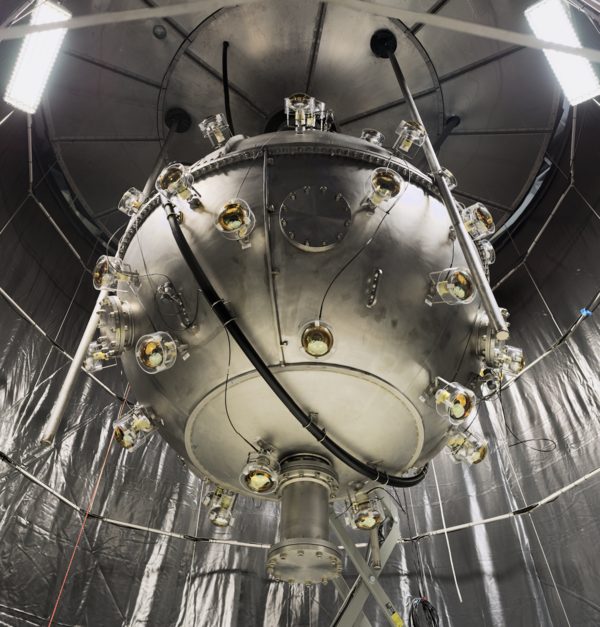Novel dark matter detector taking data, pushing limits at SNOLAB

(Sudbury) The DEAP Experiment took advantage of the international audience at the TAUP 2017 Conference to announce new results from their experiment.
Led by Carleton University Physics Professor Mark Boulay, Canada Research Chair in particle astrophysics and subatomic physics, the collaboration have released the results of their first dark matter search. The DEAP-3600 detector, operating at SNOLAB in Sudbury, Ontario since late 2016, is searching for particles of mysterious dark matter that permeate the universe. DEAP-3600 is the largest dark matter detector of its kind in the world, employing a novel technique of using only scintillation light – light generated when a particle interacts with an argon nucleus.
The origin of dark matter in our universe is one of the most important questions in particle astrophysics. One hypothesis which is currently favoured is that this dark matter is comprised of Weakly Interacting Massive Particles or WIMPs. Though not yet observed directly, the existence of dark matter can be inferred by its gravitational effects on stars and galaxies.
The DEAP Collaboration, a group of over 65 researchers from ten institutions in Canada, the UK and Mexico, has developed the DEAP-3600 detector – one of the most sensitive experiments for the direct detection of dark matter.
Boulay was happy to make the announcement, “My colleagues and I are very pleased with the early results from the DEAP-3600 experiment, which demonstrate a new technique using liquid argon for a dark matter particle search. This program will extend our sensitivity to dark matter, with the exciting potential of observing for the first time this dominant component of our universe.”
The initial result demonstrates the best-ever rejection of radioactive backgrounds using the new technique, and also the lowest level ever achieved of background radon, one of the most troublesome backgrounds in dark matter searches. Using over 3 tonnes of argon in the search for dark matter, the recent result demonstrates the power of the new technique.
Dr. Stew Smith (Princeton University) who Chairs the SNOLAB Experiment Advisory Committee, has followed this experiment since the beginning of construction, ’With this beautiful first result, the DEAP experiment has launched a new era of discovery at SNOLAB. In just three days of data from their tonne-scale detector they have reached a new level of sensitivity in searching for dark matter in liquid-argon, and are improving it with every day of continued running. Exercising extraordinary care to eliminate successfully the dangerous backgrounds from trace amounts of radioactive elements, DEAP scientists and engineers have validated argon’s potential for a giant, more-sensitive experiment. SNOLAB is an ideal site for future dark-matter searches because its 2 km depth provides powerful suppression of cosmic rays. DEAP and SNOLAB are already forging a new global collaboration to make this happen.”
With this detector, the sensitivity for dark matter can be improved and may enable the discovery of particles that account for most of the matter in our universe, but so far have remained invisible. DEAP-3600 will continue to collect data at SNOLAB until 2020, when it’s ultimate sensitivity is reached.
About SNOLAB
SNOLAB is an underground science laboratory specializing in underground science. Located 2 km below the surface in the Vale Creighton Mine located near Sudbury Ontario Canada, SNOLAB is an expansion of the existing facilities constructed for the Sudbury Neutrino Observatory (SNO) solar neutrino experiment. The facility is operated by the SNOLAB Institute whose member institutions are Carleton University, Laurentian University, Queen’s University, University of Alberta and Université de Montréal.
Media Contact
Samantha Kuula
Communications Officer
SNOLAB
705-692-7000, ext. 2222
Samantha.kuula@snolab.ca
@SNOLABscience